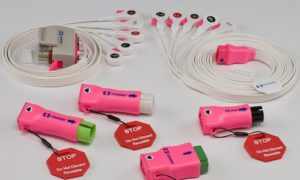
Medtronic’s Kendall disposable lead wires feature patented push button design to provide clinicians with a locking mechanism to the electrode for a stronger attachment. It is clinically proven to reduce the risk of “leads off” false alarms.
Use of disposable lead wires is growing globally, and sales are expected to reach $999.4 million by 2025. As reported by Grand View Research, a key factor driving growth is the rising incidence of hospital-acquired infections. North American hospitals are by far the largest sector of disposable lead wire adopters. Care centers with remote monitoring needs will likely see high growth in the future. Asia Pacific has seen increased adoption as the region has focused on unmet patient needs.
Reusable leads have been shown to harbor one or more antibiotic resistant pathogen, even after being cleaned and prepped. Leading OEMs have largely made a shift to disposable ECG lead sets, adapters, and cables. Such technological advances are called out by Grand View as additional drivers of the market growth over the forecast period. However, this is a price-sensitive, intensely competitive market. The demand for low cost and effective products is increasing from the consumer end. Further development of user-friendly, low-cost, and sustainable solutions is expected.
One such development is push-button alarm management. OEMs are tasked to reduce alarm events created by no telemetry, leads fail or leads off since fewer ECG alarms save nurses time, decrease alarm fatigue, and improve patient safety. Various OEMs are offering lead wires that address the risk of false clinical or nuisance alarms.
Other findings in the report address preferred materials used in manufacturing the lead wires, as well as machine types that will see the most growth. The research firm expects lead wires made with thermoplastic elastomers (TPEs) to perform better than those made with PVC or rubber latex. TPEs may provide better flexibility and processes, in addition to their role in infection control. The demand of the 5-lead machine type is expected to increase in coming years owing to the surge in demand for cost effective equipment in critical care settings.
[Want to stay more on top of MDO content? Subscribe to our weekly e-newsletter.]




